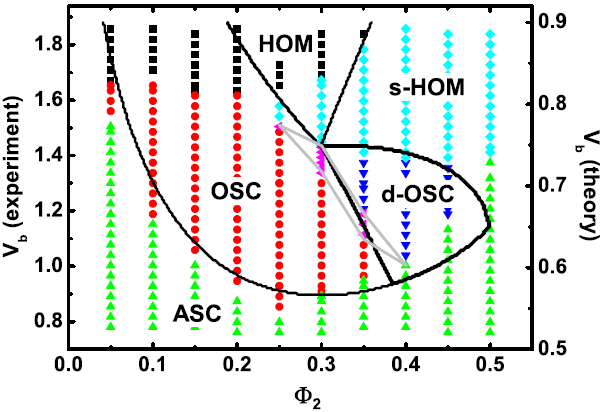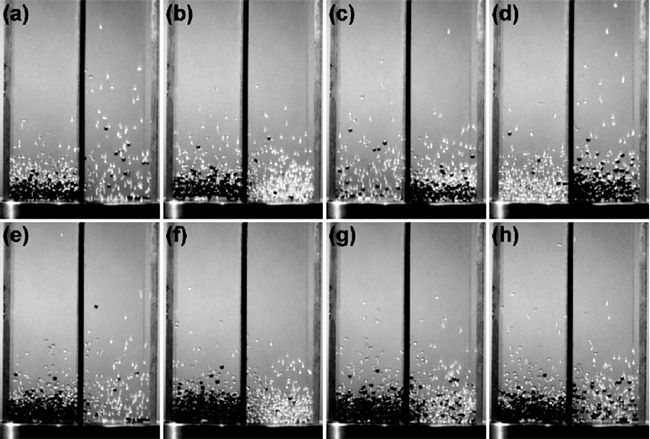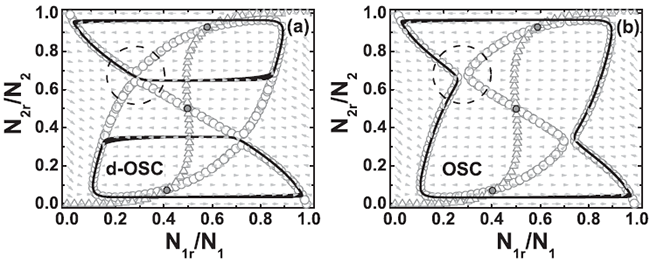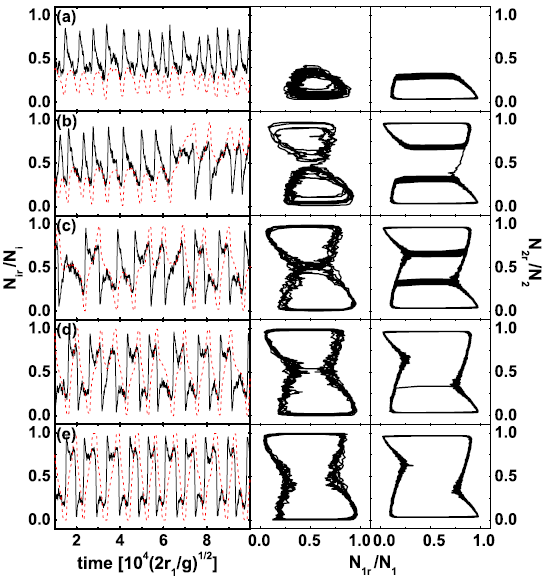
Different from molecular gas, gas systems formed by macroscopic particles need energy input to balance the dissipation caused by the inelastic collisions between particles. The granular gas system is therefore considered as a far-from-equilibrium system. In this system the Maxwell’s Demon phenomenon, a phenomenon that fast and slow particles will be segregated in a connected compartmentalized container without external forces was recently observed. More interestingly, oscillatory behavior can be observed in compartmentalized granular gas system if one replaces the mono-disperse gas by a bi-disperse one. This observation makes the bi-disperse system possibly a new nonlinear model system. However, the oscillatory behavior in the bi-disperse compartmentalized granular gas is yet lack of thorough understanding.
The research group led by prof. HOU Meiying of Institute of Physics has studied this oscillatory behavior and achieved a series of research accomplishments. They have found that the oscillatory phenomena are not necessarily a consequence of the reverse Brazil nut effect, rather a result of the inequality in collision properties of the two kinds of particles.
They have also elaborated that the transition from the HOM state to the OSC state is due to a Hopf bifurcation [Phys. Rev. Lett. 100, 068001 (2008)] and predicted through MD simulation the existence of a new state, d-OSC state, a state with large (or heavy) particles partly participate in the oscillation cycles as the small (light) particles do [Phys. Rev. E 79, 052301 (2009)]. In the phase diagram, the OSC state corresponds to the single limit cycle, while d-OSC state to a phase of double limit cycles. The mechanism of the transition between d-OSC state and OSC state was not yet clear.
In a recent publication [Phys. Rev. Lett. 109, 198001 (2012)], Dr. LI Yinchang, Dr. LIU Rui and prof. HOU Meiying have reported their most recent experimental observation, which confirmed the existence of the d-OSC state. In this paper, a homoclinic gluing bifurcation in a bi-disperse granular system was observed for the first time, which enriches the nonequilibrium dynamics of the system and may make it a model system for nonlinear dynamics.
The irregular oscillation among the OSC and d-OSC states was illustrated by a flux model. Noise dominated hopping near bifurcation points was also demonstrated. It is found that noise plays an important role in the system, which induces a striking hopping effect and leads to a low-frequency divergent i-OSC state around the gluing point. The system may lead to chaos when extended to higher dimensions with more than two species or more than two compartments.
 |
| Fig. 1 Phase diagram (Image by HOU Meiying et al) |
 |
| Fig. 2 Experimental snapshots: OSC state (a)-(d), d-OSC state (e)-(h) (Image by HOU Meiying et al) |
 |
| Fig. 3 Phase trajectories of the d-OSC state (a) and OSC state (b) near the gluing point. (Image by HOU Meiying et al) |
 |
| Fig. 4 Noise-induced hopping near the homoclinic bifurcation point: (a) d-OSC state, (b) hopping at d-OSC limit cycles, (c) near critical point hopping among OSC and d-OSC, (d) hopping at OSC limit cycle, (e) OSC state. (Image by HOU Meiying et al) |

86-10-68597521 (day)
86-10-68597289 (night)

86-10-68511095 (day)
86-10-68512458 (night)

cas_en@cas.cn

52 Sanlihe Rd., Xicheng District,
Beijing, China (100864)

